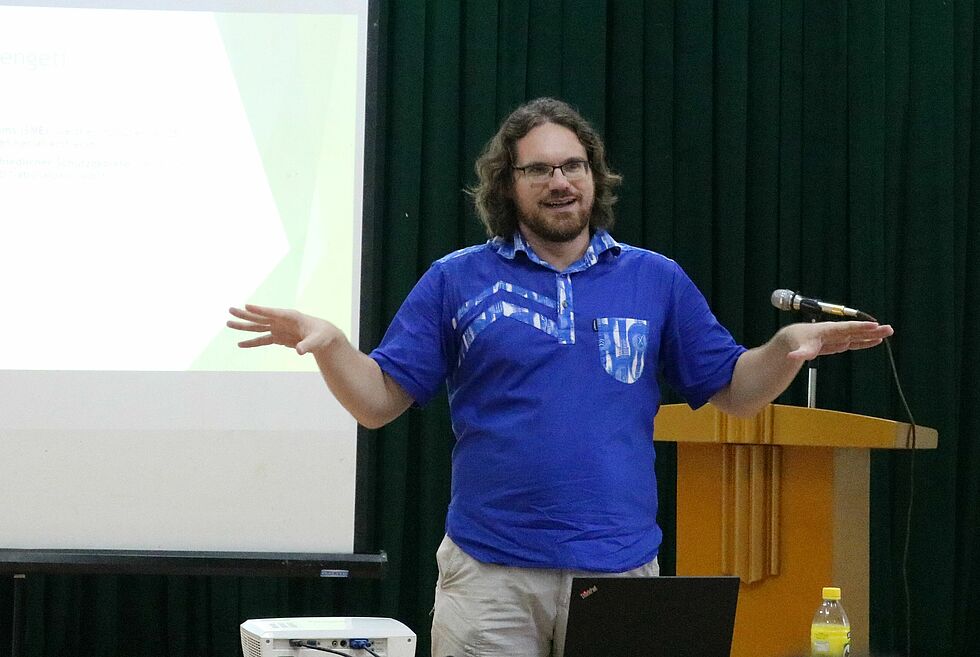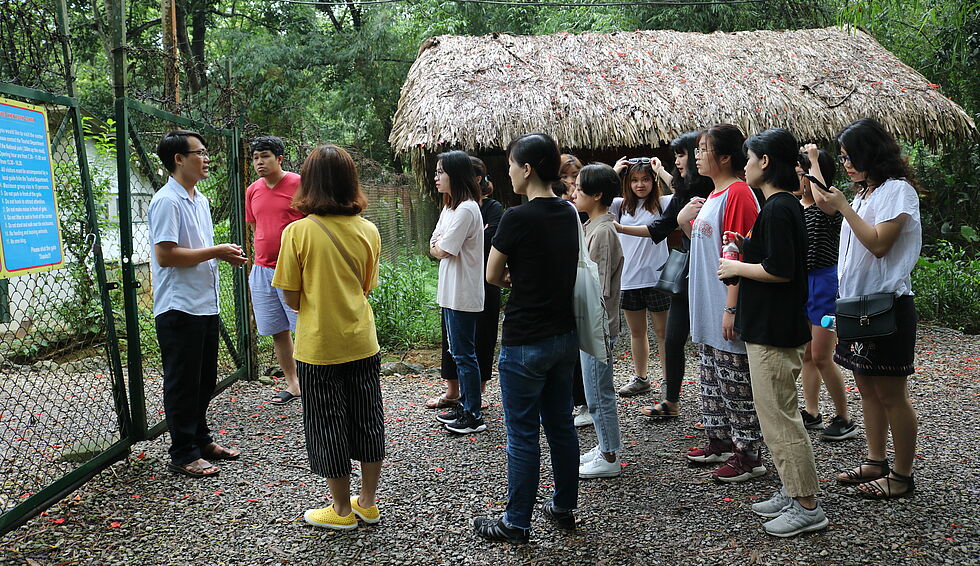Upgrading infrastructure vs. nature protection
Mr. Daniel Mann explained relevant terms such as species protection, biosphere reserves, habitat, etc.|© FES Vietnam
As part of Friedrich-Ebert-Stiftung (FES) annual youth activities, a discussion round and excursion on the topic “Nature protection and biodiversity” was organized from May 31st to June 1, 2019 in Cuc Phuong, Ninh Binh. Students of the Hanoi University (HANU) and the Vietnam National University (VNU) with a major in German language were attending the event. During the two-days-trip, the students had the opportunity to exchange ideas with Dr. Daniel Mann, Project Assistant of FES Ghana, who gave inputs on “Infrastructure development and nature conservation” as well as “Species protection through territorial protection”.
So far, building infrastructure is mainly considered as a contributor to economic growth, hence neglecting the negative effects on the environment. Not only in Vietnam, highway projects become more and more popular because of increasing demand of both local people and investors on transportation across the country or beyond the border. This discussion platform and excursion aimed to rise the student’s awareness on the topic and provide best-practise examples for alternative concepts on minimizing the impact of construction and infrastructure development on nature and biodiversity.
Following the inputs of German expert with experience sharing from Kenya and Tanzania via their Serengeti Highway projects, students from VNU added a presentation on nature protection in Vietnam and showed up the case of building the Ho Chi Minh highway which raised a big debate a few years ago. The reason for controversial opinion among Vietnamese experts lied in the fact that the highway was originally planned crossing the Cuc Phuong National Park which would have harmed the ecological balance and biodiversity of the region.
Beside the theoretical parts, the excursion to the well-known rescue and conservation centres in Cuc Phuong provided participants with a deep understanding about the rescue work and how to better preserve rare and precious animal species. The excursion was marked with a very first visit to the Carnivore and Pangolin Education Centre. There, many students were highly impressed by the way small animals and pangolin had been softly treated. “Some wild animals became so rare because of illegal hunting and trading for so-called miraculous medicine”, stated Mr. Nguyen Manh Quyen, a local expert working at Cuc Phuong National Park. He added “Pangolins are animals that can be easily caught, because they cannot attack or escape quickly. There are often cases in which animals were seriously injured when they were transferred to this rescue centre.”
The first stop on the second day was the Endangered Primate Rescue Centre (EPRC). There, the participants learned the differences in living style of each primate types. Some primates prefer to live together as a family, some are not willing to do so. Another interesting thing is that some primates are exceptionally active and getting bored pretty fast. Consequently, toys and playground for primates need to be changed or renewed on a regular basis. At the centre, there is also a special area where primates are trained some “soft skills”, so that they can exist when being brought back to the nature. “As primates used to live in the rescue centre with food provided, they almost lose their instinct and basic skills. That is why they should regain those skills in a probation period, in order to survive in a future life outside the centre, which is normally very hard with extreme challenges”, said Ms. Dinh Thi Thu Huong, one of the guides at the rescue centre.
The excursion continued visiting the Turtle Conservation Centre. For most participants, it was very interesting to see the diversity in types and characteristics of the turtles. Nguyen Thu Huyen, a student from HANU shared: “Now I know how to differentiate the gender of each animal types based on their specific features.” However, turtles are a kind of animal that is easily be threaten with extinction. Mr. Nguyen Manh Quyen sadly told “Turtles are in highest danger. Only one or two turtles are born under hundreds of eggs. It’s a pity that the old turtle in Hoan Kiem Lake died. Currently this type of turtle is very rare and could not be reproduced anymore.”
After the visits to the conservation and rescue centres, the students confessed that they haven’t yet noticed the bad impacts of construction and infrastructure upgrading on the nature and biodiversity. It is true that the normal life of animals, especially wild and rare ones could be messed up with the change of the environment. For many wildlife species, the forest is their home. Thus, it is nonsense to destroy the living areas of other animals just for meeting the increasing demands on transportation or commerce of human beings.
The programme ended up with a group work as well as a short presentation of each group’s discussion result. All participants agreed that small actions in daily life could contribute to the preservation of nature and biodiversity, such as recycling, reducing plastic waste, joining hands in using renewable energy and fighting against illegal wildlife trade, etc.




